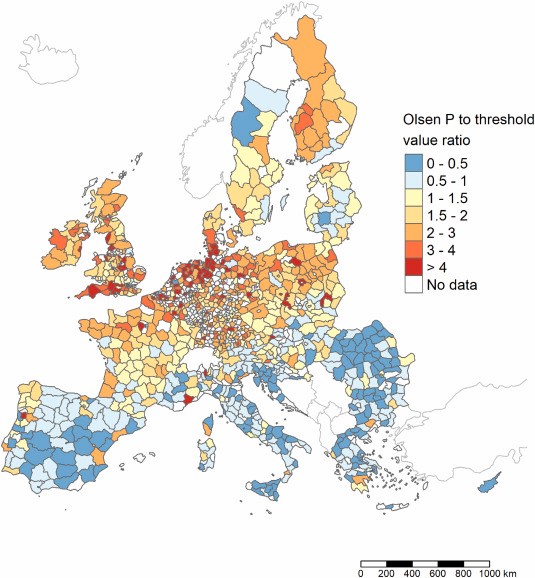There is a general consensus in the scientific community on the implications that phosphorus (P) will have on future agricultural production and food security, as a finite and highly strategic resource. Europe is highly dependent on imported P. Overcoming the consequences of future scarcity of P is crucial to ensure agriculture sustainability. This requires decision-making processes grounded on data on the phosphorus status of agricultural soils, commonly conducted with chemical extractions called “soil P tests” (SPTs), and the efficient use of the phosphorus resource on a societal scale following a circular economy approach.
In LEX4BIO we have studied a more precise allocation of phosphorus fertilizer in Europe. This is possible by identifying sites where agricultural production can be increased with phosphorus fertilizers, which required accurate information on the phosphorus contained in soil. For a precise allocation of phosphorus fertilizer as a basis for its sustainable use, it was necessary to define the level of chemically extractable soil phosphorus (SPT) above which the crop yields will not be increased with the application of phosphorus fertilizers. This level is also known as “threshold value” for fertilizer response. This was not a single task, since different chemical extractants are used in Europe as a basis for phosphorus fertilizer recommendations and also because the threshold value for fertilizer response varies for the same extractant depending on soil properties in the various geographical regions. We worked with a single extraction with bicarbonate (the Olsen P method), which is widely used. Based on an extensive literature review, we established a single model based on soil properties, to estimate the threshold value for phosphorus fertilizer response with this extraction method.
A response to phosphorus fertilizer application, i.e., an increase in crop yields with fertilization, is not expected when the current Olsen P level is above its estimated threshold value, i.e. the ratio of Olsen P to threshold value is higher than 1. Using the Olsen P values from the European LUCAS project soil database we defined threshold values of Olsen P for different European regions (Figure 1) and concluded that in the EU-28 (including United Kingdom), an increase in crop yields with phosphorus fertilization was not expected in 70 % of the croplands (see Figure 2 which describes the above-mentioned ratio for NUTS3 regions in the EU) and in 60 % of the grasslands (see Figure 3, also for NUTS3 regions).
Furthermore, we estimated the phosphorus fertilizer demand in the EU-28 on the basis of the current soil phosphorus status and on the predicted extraction by crops. Although this demand is not lower than the current phosphorus fertilizer consumption, we concluded that a better allocation is possible, which will consequently decrease the fertilizer demand in the future. Importantly, most of the European demand for P could be covered by recycling P from manure, wastewater and municipal solid waste. This would decrease the need for inputs of mineral P produced from finite mined deposits by about 75%.

Figure 1. Bicarbonate extractable phosphorus (Olsen P) threshold values for fertilizer response, i.e. values above which an increase in crop yields is not expected upon phosphorus fertilizer application, for NUTS3[1] regions (median values for each region) in the EU-28 according to soil analysis in the LUCAS project conducted in 2015.

Figure 2. Current ratio of bicarbonate extractable phosphorus (Olsen P) to estimated threshold values in the NUTS3 regions of EU-28 (median values) in croplands

Figure 3. Current ratio of bicarbonate extractable phosphorus (Olsen P) to estimated threshold values in the NUTS3 regions of EU-28 (median values) in grasslands
This blog post is based on the scientific paper “Assessing the phosphorus demand in European agricultural soils based on the Olsen method” – https://doi.org/10.1016/j.jclepro.2022.134749
[1] The NUTS classification (Nomenclature of territorial units for statistics) is a hierarchical system for dividing up the economic territory of the EU and the UK for the purpose of:
- the collection, development and harmonisation of European regional statistics
- socio-economic analyses of the regions
- NUTS 1: major socio-economic regions
- NUTS 2: basic regions for the application of regional policies
- NUTS 3: small regions for specific diagnoses

